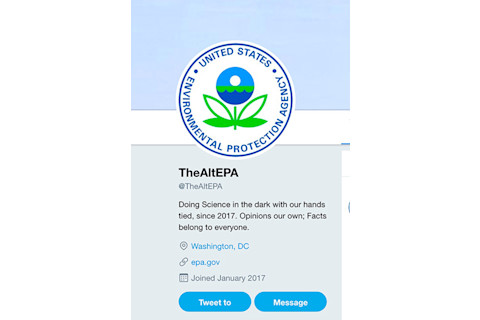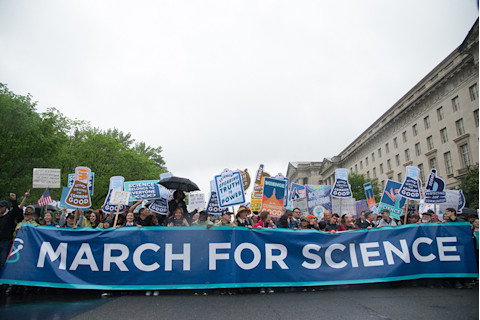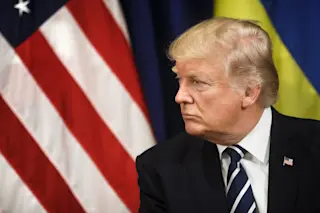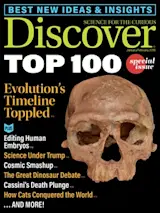For many who value science, 2017 will be remembered as the dawn of a new era. January saw the inauguration of a U.S. president who has denied climate change and filled his inner circle with anti-science activists. But the year was as much an awakening as an annus horribilis: Researchers and citizens alike, in the United States and beyond, chose to speak out at rallies, on social media and even in the political arena — unprecedented numbers of scientists are considering a run for office.
In a year of surprises, setbacks and signs of hope, here are some of the most memorable and consequential moments from the first several months of the new administration.

Twitter/TheAltEPA
January 2017
25: In response to a media blackout ordered for the Environmental Protection Agency (EPA), entities such as “TheAltEPA” and “RogueNASA,” ostensibly created by frustrated federal employees, begin posting climate change data and other science-based information on social media.
February
17: The Senate confirms Scott Pruitt as head of the EPA, the same agency the former Oklahoma attorney general and committed climate change denier had sued multiple times in attempts to weaken its regulatory reach.
March
2: The Senate confirms former Texas governor and climate change skeptic Rick Perry as Energy secretary, six years after then-presidential candidate Perry called for the Department of Energy’s elimination
28: The president signs Executive Order 13783, which calls for the review and rescinding of many environmental protections.

A pro-science rally in Washington, D.C., drew roughly 100,000 participants; many more rallied at sister events across the world. | Zach D Roberts/NurPhoto via Getty Images
April
22: A crowd of roughly 100,000 gathers to “March for Science” in Washington, D.C. Nearly a million more individuals participate in local events in all 50 states and on every continent.
24: President Trump urges NASA to send a manned mission to Mars despite his proposal to cut the space agency’s budget.
28: The EPA removes climate change data and other information from its website.
May
18: Under Ajit Pai — who was appointed chairman by Trump — the FCC votes to begin dismantling net neutrality safeguards that were put in place in 2015. The decision opens the door to internet service providers controlling which sites consumers access.
23: A proposed budget released by the White House slashes funding for both the EPA and FDA by 31 percent. The Centers for Disease Control and Prevention (CDC), Department of Energy and the National Institutes of Health would also see significant cuts.
June
1: The president announces plans to withdraw the U.S. from the Paris Climate Agreement.
8: Following up on President Emmanuel Macron’s June 1 offer to “make our planet great again” by welcoming American scientists, the French government unveils a website offering foreign researchers French residency and four-year grants of up to 1.5 million euros (about $1.76 million).
22: The Department of the Interior (DOI) ends endangered species protection for Yellowstone grizzlies despite a two-year decline in the population, paralleling other administration decisions to remove protections for wildlife.
July
19: Trump nominates Sam Clovis, who has no science background, to be the USDA’s chief scientist. (Clovis's nomination would be withdrawn Nov. 2, after his name surfaces in an ongoing investigation into Russian influence on the Trump campaign.)
20: Six months into the administration, the president has yet to nominate candidates for a record number of key positions in science-driven government agencies such as the CDC and EPA.
August
15: Trump signs an executive order removing requirements for federal properties to withstand increased flooding and other climate change-related challenges.
23: State Department science envoy Daniel Kammen quits over the president’s decision to leave the Paris agreement and his response to a white supremacist rally in Virginia. Kammen’s resignation letter includes an acrostic: The first letter of each paragraph spells “IMPEACH.”
24: The DOI announces plans to downsize three national monuments, including Bears Ears in Utah, despite pleas from Native Americans, archaeologists and paleontologists to protect culturally and scientifically significant sites.
31: The DOI limits most environmental impact studies to a year in length and resulting reports to no more than 150 pages. The studies previously lasted for years and could run 1,000 pages or more.
September
29: The FDA delays required revisions to nutrition labeling by up to three years. The updates, which would have gone into effect in 2018, include more realistic portion sizes and the amount of added sugar in a product.
October
10: The administration announces its intent to kill the Clean Power Plan, an Obama-era initiative to limit carbon dioxide emissions from power plants.
31: EPA head Pruitt says he will bar any scientist who receives agency grants from serving on its advisory boards. The move opens the door for industry-funded researchers to take their place.
November
3: The White House releases a Climate Science Special Report, part of a congressionally mandated assessment. The conclusion? Human activity is the dominant cause of climate change, contradicting many administration statements.
Sidebar: The Paris Exit
In 1992, some 150 countries signed the U.N. Framework Convention on Climate Change (UNFCCC) with the goal of flat-lining greenhouse gases. At the time, the 1987 Montreal Protocol had already kick-started the healing of the ozone hole, so scientists expected the UNFCCC would succeed, too. However, emissions continued to increase.
In late 2016, nations of the world convened again. Their optimistic goal: keep global warming below 1.5 degrees Celsius to avoid doomsday scenarios of rising seas, widespread droughts and melting ice. That would mean zero greenhouse emissions by 2050 — an incredible feat. Every country but the United States has since ratified the Paris agreement.
By June, reaching that goal seemed questionable after President Donald Trump announced the U.S. would withdraw, though pact rules dictate a four-year wait. European nations, plus China, are moving toward their goals regardless. And energy trends may help: Solar and wind power costs have plummeted, and carbon dioxide emissions in the U.S. have dropped amid shifts from coal to natural gas. — Eric Betz















